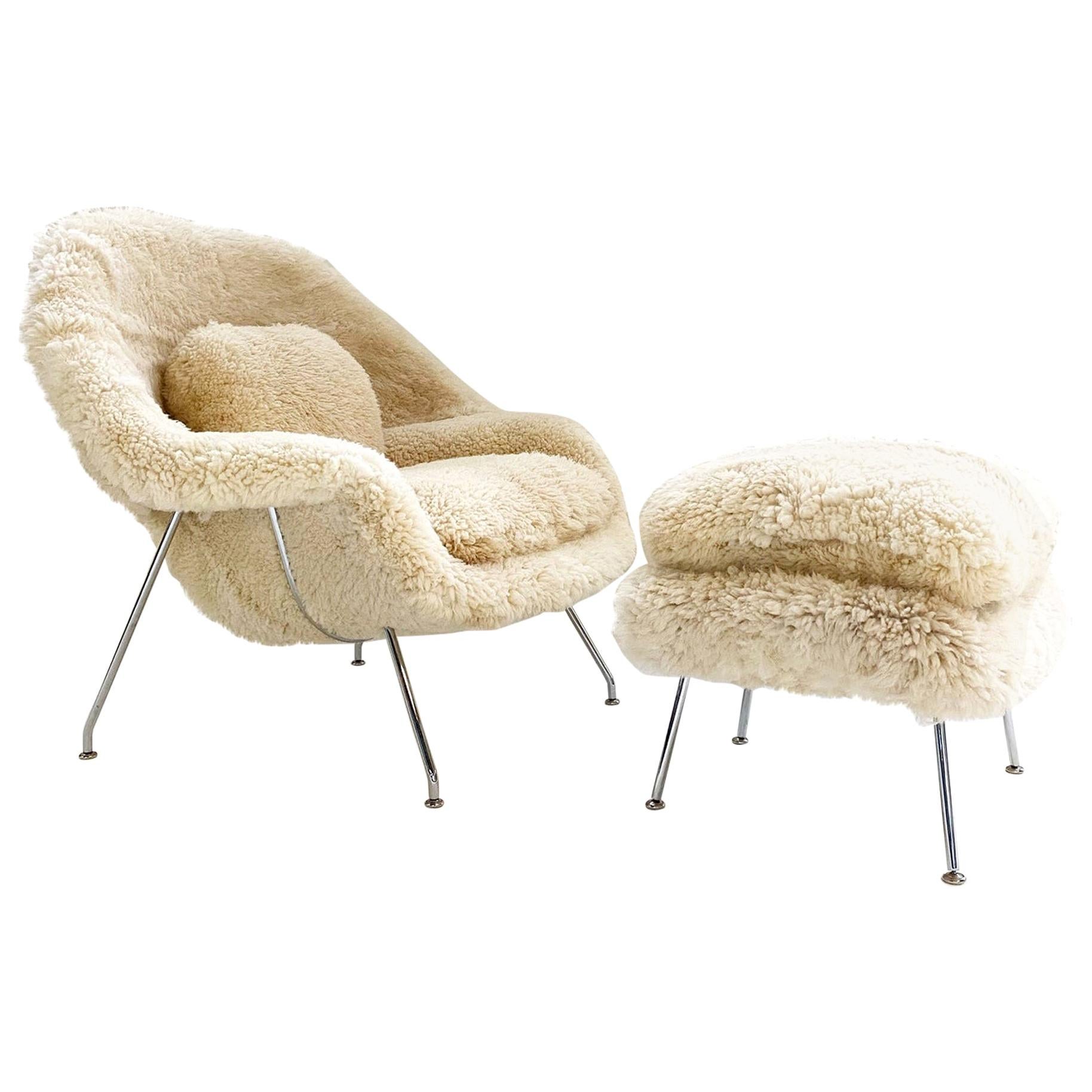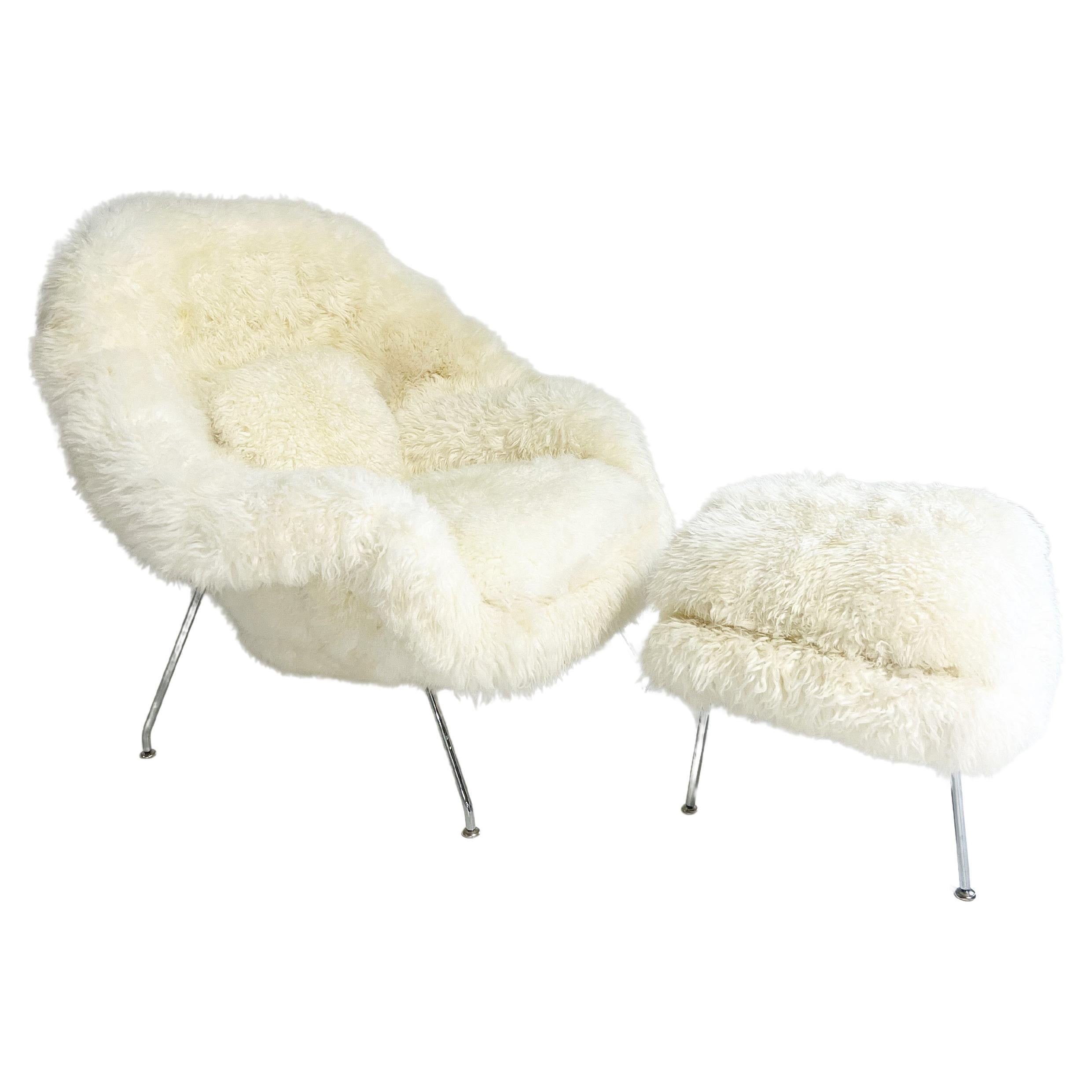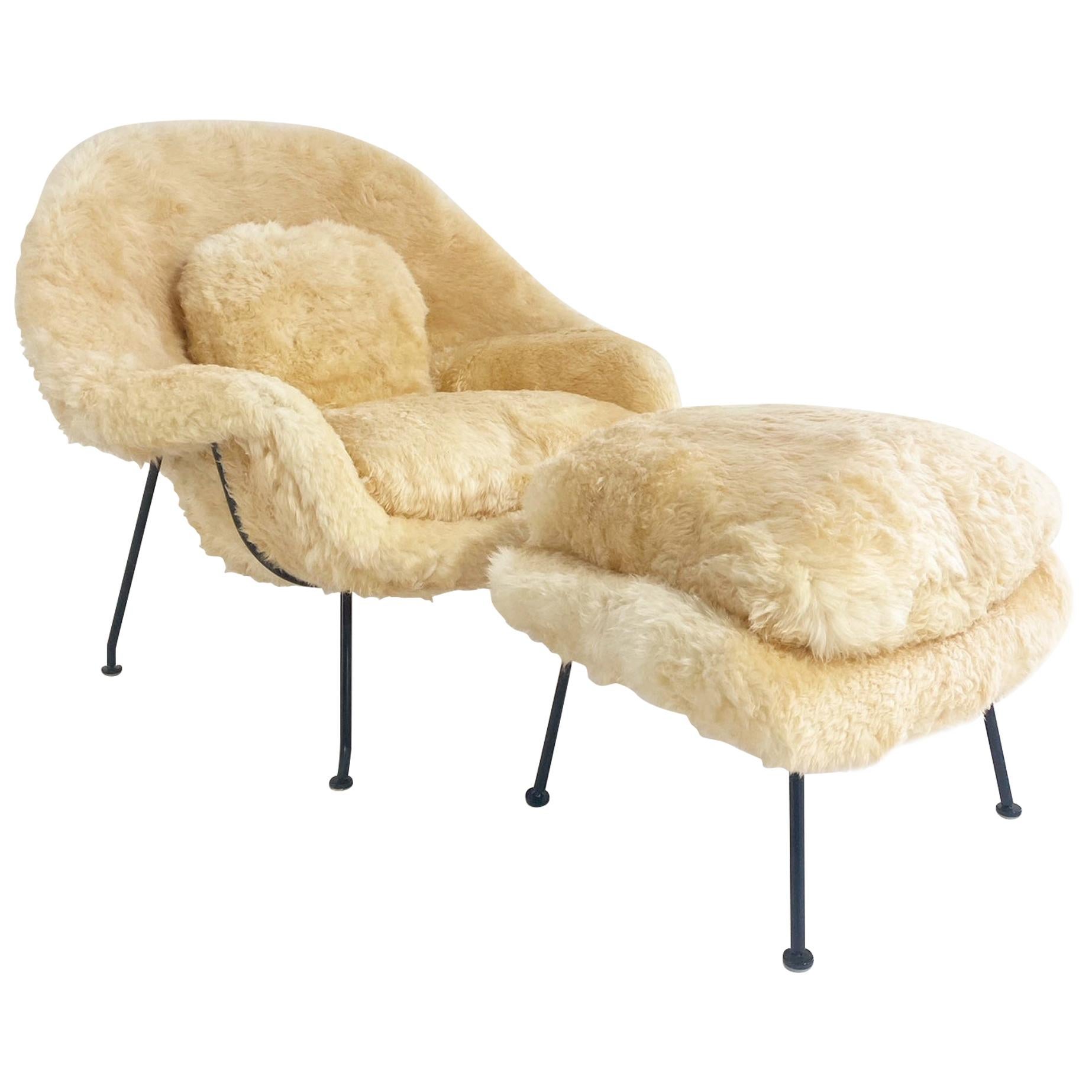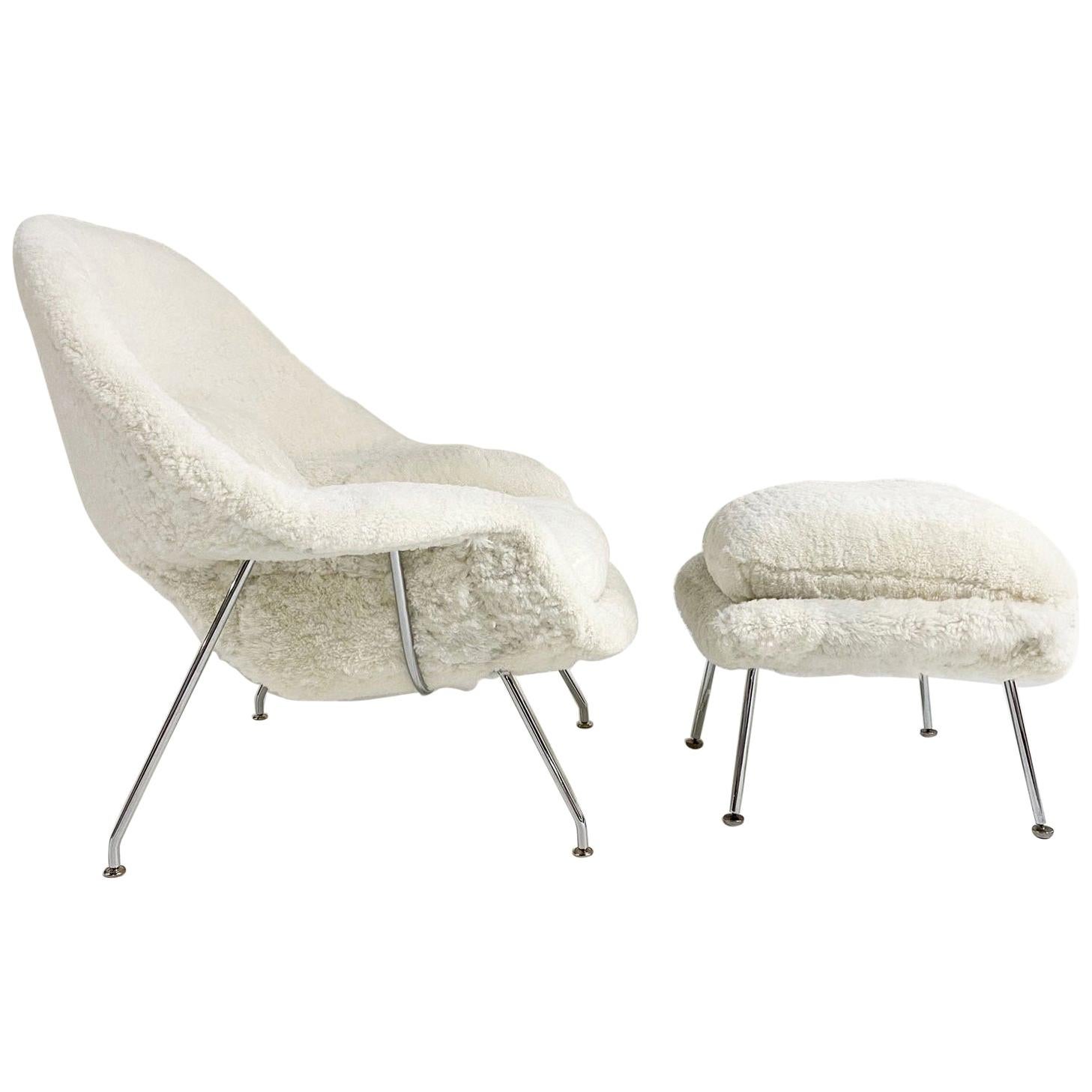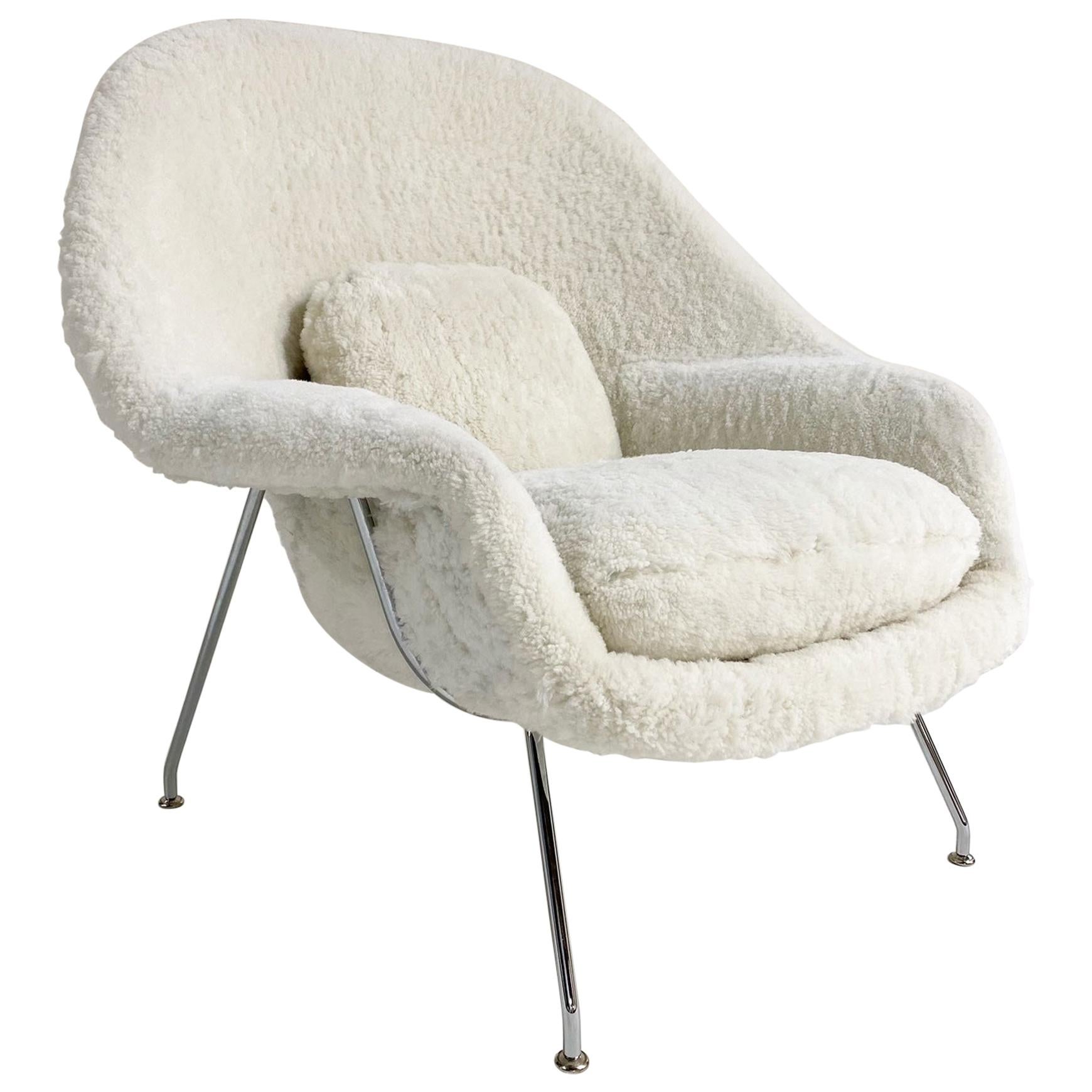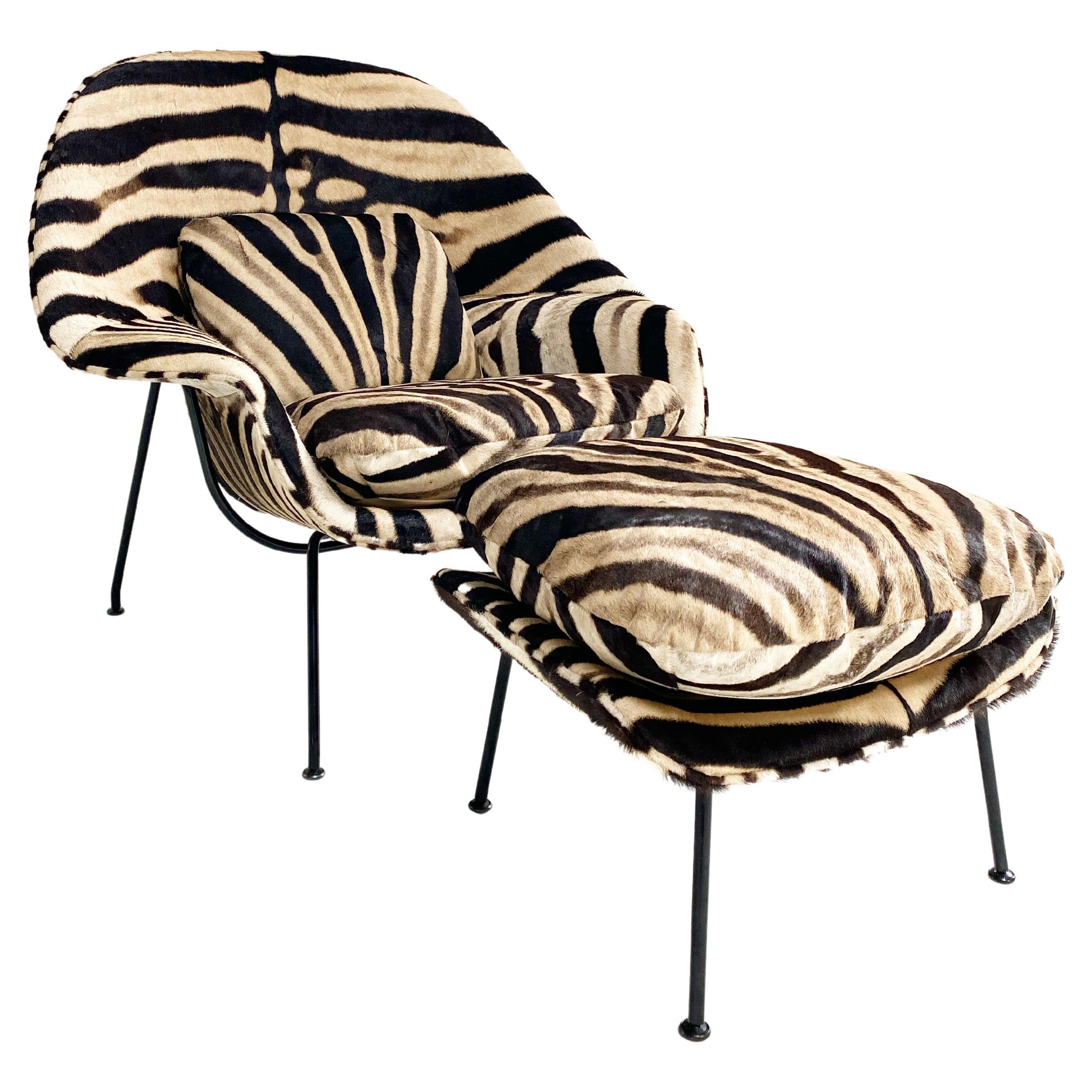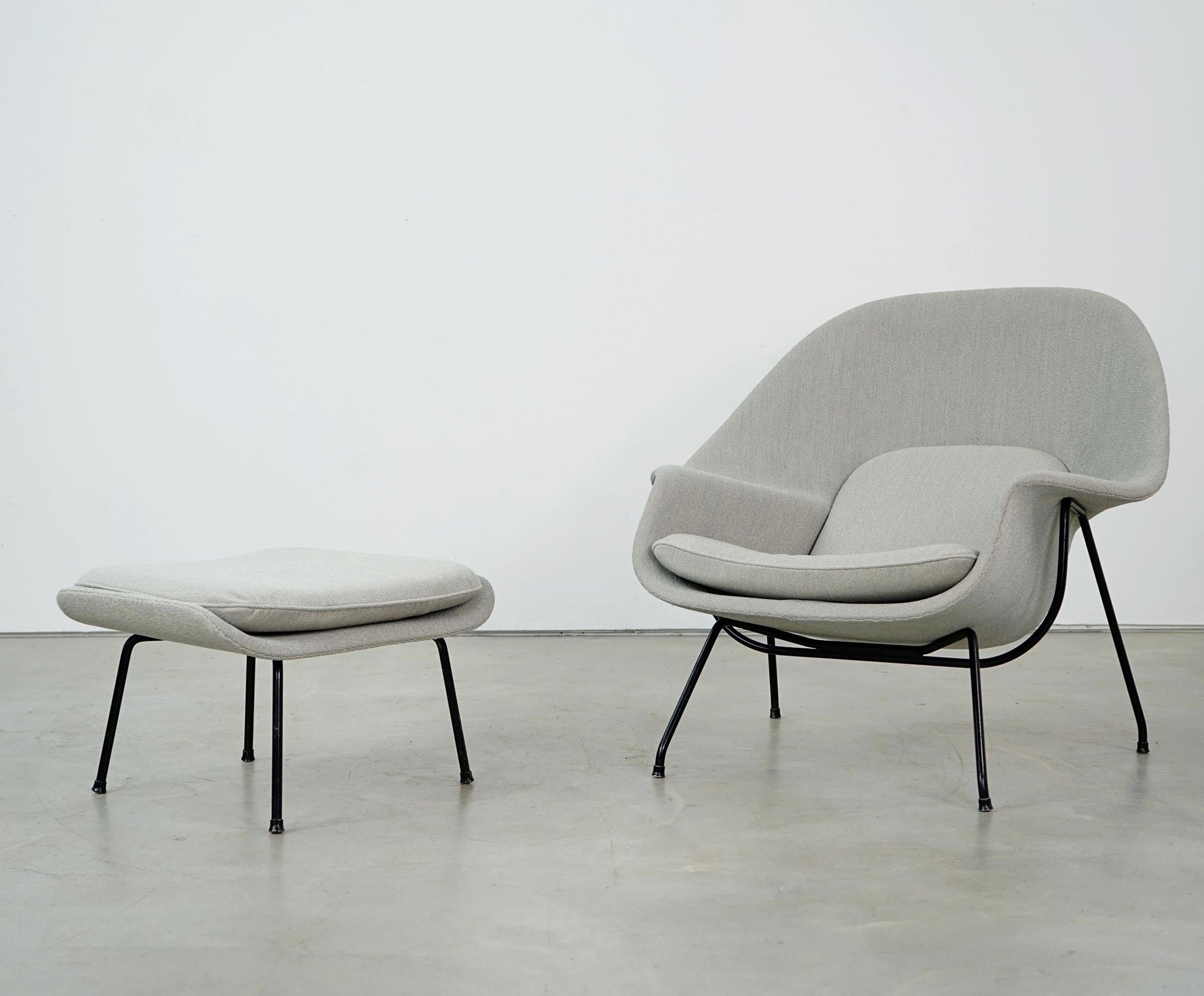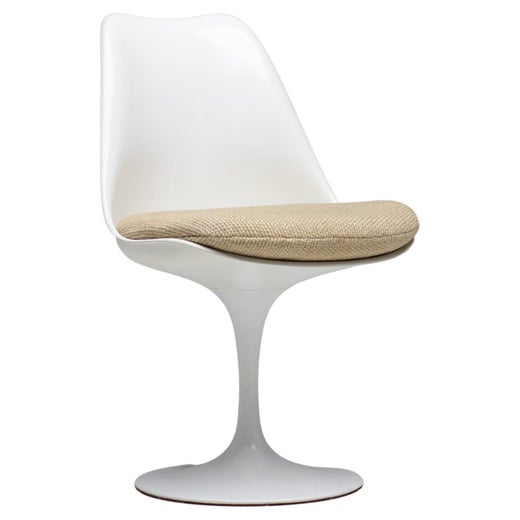Forsyth Bespoke Eero Saarinen Womb Chair and Ottoman in California Sheepskin
About the Item
- Creator:Knoll (Manufacturer),Eero Saarinen (Designer)
- Design:
- Dimensions:Height: 35 in (88.9 cm)Width: 41 in (104.14 cm)Depth: 39 in (99.06 cm)Seat Height: 17.5 in (44.45 cm)
- Style:Mid-Century Modern (Of the Period)
- Materials and Techniques:
- Place of Origin:
- Period:
- Date of Manufacture:21st Century
- Condition:Reupholstered. Wear consistent with age and use. Metal legs in very good vintage condition. The chair will be completely restored and freshly upholstered in our California sheepskins.
- Seller Location:SAINT LOUIS, MO
- Reference Number:1stDibs: LU1701218334322
Womb Chair
Shortly after Eero Saarinen (1910–61) joined Florence Knoll at the manufacturer she had established with her husband, Hans, she presented the Finnish-born designer with a serious request: to create for her the world’s most comfortable chair, something, Saarinen recalls, that felt like “a basket full of pillows.”
Presented with the challenge, Saarinen went primal. What, the designer figured, better signifies the very essence of comfort than the womb? "It was designed on the theory that a great number of people have never really felt comfortable and secure since they left the womb,” the designer said of his chair, which began production in 1948. “The chair is an attempt to rectify this maladjustment in our civilization.”
The Womb chair, like many other masterpieces of modernist design, is genius in its simplicity. Comprised of few materials, the chair consists of a fabric-wrapped, molded fiberglass bucket set atop legs of tubular steel. The skeletal look of the frame keeps the chair from appearing bulky despite the seat’s oversized silhouette, which makes it inviting to people of all sizes.
"There seemed to be a need for a large and really comfortable chair to take the place of the old overstuffed chair,” Saarinen once said of his concept. Indeed, despite being indisputably comfortable, the Womb doesn’t require an abundance of padding and tufting — instead, its comfort owes to a perfectly shaped shell of fiberglass. This new approach to ergonomics both reflected Saarinen’s love of streamlined forms and echoed the kind of experimental work being done by American designers Charles and Ray Eames, who, like Florence Knoll, were friends he'd made at Cranbrook Academy of Art while he taught there.
It didn’t take long for the chair to become a cultural phenomenon; in the decade following its release, it appeared in a Coca-Cola commercial, a New Yorker cartoon and in a Norman Rockwell painting on the cover of The Saturday Evening Post. Today, Knoll offers the seat in some 15 upholstery options, and when Saarinen’s famous TWA terminal reopened as a hotel in 2019, Womb chairs featured prominently in the guest rooms, continuing the legacy of this classic design.
Eero Saarinen
Through his work as an architect and designer, Eero Saarinen was a prime mover in the introduction of modernism into the American mainstream. Particularly affecting were the organic, curvilinear forms seen in Saarinen’s furniture and his best-known structures: the gull-winged TWA Flight Center at John F. Kennedy airport in New York (opened 1962), Dulles International Airport in Virginia (1962) and the Gateway Arch in St. Louis, Missouri (1965).
Saarinen had a peerless modernist pedigree. His father, Eliel Saarinen, was an eminent Finnish architect who in 1932 became the first head of the Cranbrook Academy of Art in suburban Detroit. The school became synonymous with progressive design and decorative arts in the United States, and while studying there the younger Saarinen met and befriended several luminaries of mid-century modernism, among them Harry Bertoia and Charles and Ray Eames.
At Cranbrook, Saarinen also met Florence Schust Knoll, who, as director of her husband Hans Knoll's eponymous furniture company, would put Saarinen’s best designs into production. These include the Grasshopper chair, designed in 1946 and so named because its angled bentwood frame resembles the insect; the Tulip chair (1957), a flower-shaped fiberglass shell mounted on a cast-aluminum pedestal; and the lushly contoured Womb lounge chair and ottoman (1948). In his furniture as in his architecture, the keynotes of Eero Saarinen’s designs are simplicity, strength and grace.
Find vintage Eero Saarinen tables, chairs and other furniture on 1stDibs.
- ShippingRetrieving quote...Ships From: SAINT LOUIS, MO
- Return PolicyA return for this item may be initiated within 10 days of delivery.
- Forsyth Bespoke Eero Saarinen Womb Chair Without Ottoman in California SheepskinBy Knoll, Eero SaarinenLocated in SAINT LOUIS, MONote: The listing is for womb chair only, no ottoman included. A favourite of the Forsyth design team! We have an incredible collection of vintage chairs and design icons waiting f...Category
Mid-20th Century American Mid-Century Modern Lounge Chairs
MaterialsSheepskin
- Forsyth Bespoke Eero Saarinen Womb Chair and Ottoman in Wavy SheepskinBy Knoll, Eero SaarinenLocated in SAINT LOUIS, MOLead Time: Please allow 10 to 12 weeks to restore a vintage Womb Chair and Ottoman in our wavy New Zealand sheepskin "Eero Saarinen designed the groundbreaking Womb chair at Flore...Category
2010s American Mid-Century Modern Lounge Chairs
MaterialsChrome
- Forsyth Bespoke Eero Saarinen Womb Chair and Ottoman in Texas SheepskinBy Knoll, Eero SaarinenLocated in SAINT LOUIS, MOA favorite of the Forsyth design team! We have an incredible collection of vintage chairs and design icons waiting for a new life. Our upcycled womb chairs are some of our most p...Category
Mid-20th Century American Mid-Century Modern Lounge Chairs
MaterialsSheepskin
- Forsyth Bespoke Eero Saarinen Womb Chair and Ottoman in Australian SheepskinBy Knoll, Eero SaarinenLocated in SAINT LOUIS, MOA favourite of the Forsyth design team! We have an incredible collection of vintage chairs and design icons waiting for a new life. Our upcycled womb chairs are some of our most popular designs. This womb chair and ottoman will be made to order with the finest Australian sheepskins...Category
2010s American Mid-Century Modern Lounge Chairs
MaterialsSheepskin
- Forsyth Bespoke Eero Saarinen Womb Chair in Australian SheepskinBy Knoll, Eero SaarinenLocated in SAINT LOUIS, MOWe have an incredible collection of vintage chairs and design icons waiting for a new life. Our upcylced womb chairs are some of our most popular designs. This womb chair will be made to order with the finest Australian sheepskins...Category
Mid-20th Century American Mid-Century Modern Lounge Chairs
MaterialsSheepskin
- Forsyth Bespoke Eero Saarinen Womb Chair and Ottoman in ZebraBy Knoll, Eero SaarinenLocated in SAINT LOUIS, MOA favorite of the Forsyth design team! We have an incredible collection of vintage chairs and design icons waiting for a new life. Our upcycled Womb Chairs are some of our most popul...Category
2010s American Mid-Century Modern Lounge Chairs
MaterialsZebra Hide
- Eero Saarinen for Knoll Womb Chair and OttomanBy Eero Saarinen, KnollLocated in Philadelphia, PAEero Saarinen for Knoll Womb Chair and ottoman. Probably one of the most comfortable chairs ever created! This chair and ottoman d...Category
Vintage 1960s American Mid-Century Modern Lounge Chairs
MaterialsMetal
- Eero Saarinen Womb Chair and Ottoman in Golden Teddy Bear SheepskinBy Eero SaarinenLocated in Saint Louis, USRelax and unwind in this beautifully comfortable original Eero Saarinen Womb Chair and ottoman set. The chair is accompanied by an ottoman of which both are fully reupholstered in hi...Category
Vintage 1960s American Mid-Century Modern Lounge Chairs
MaterialsSteel
- Eero Saarinen Womb Chair and Ottoman, Knoll, USA, 1950sBy Knoll, Eero SaarinenLocated in London, GBAn early production Eero Saarinen womb chair and ottoman, made by Knoll, USA, 1950s. Newly upholstered in luxurious pure Alpaca fabric (brown / grey) with a structure of fibreglass, black enameled steel frames and first edition feet / glides. Fast shipping worldwide. When asked by Florence Knoll to design 'a chair that was like a basket full of cushions - something she could really curl up in', Eero Saarinen produced the Womb chair...Category
Mid-20th Century American Mid-Century Modern Lounge Chairs
MaterialsSteel
- Eero Saarinen vintage Womb Chair and Ottoman for KnollBy Knoll, Eero SaarinenLocated in Houston, TXEero Saarinen Knoll International USA 1946 upholstery, painted steel chair: 35 h × 41 w × 35 d inches Vintage Eero Saarinen womb chair and ottoman for Knoll...Category
Mid-20th Century American Mid-Century Modern Lounge Chairs
MaterialsSteel
- 1960's Eero Saarinen for Knoll Womb Chair and OttomanBy Eero Saarinen, KnollLocated in Palm Springs, CAA lovely example of the Iconic Womb Chair and Ottoman designed by Eero Saarinen for Knoll. We have had it re-upholstered in a genuine Knoll fabric, Crossroads in a Honey Bee color. T...Category
Vintage 1960s American Mid-Century Modern Lounge Chairs
MaterialsSteel
- Vintage Midcentury Womb Chair and Ottoman by Eero SaarinenBy Knoll, Eero SaarinenLocated in Oxnard, CAHere is an absolutely striking Womb chair and ottoman by Eero Saarinen for Knoll. This iconic lounge chair has been expertly reupholstered in premium Knoll "Cato" fabric. The now ubi...Category
Mid-20th Century American Mid-Century Modern Lounge Chairs
MaterialsSteel
